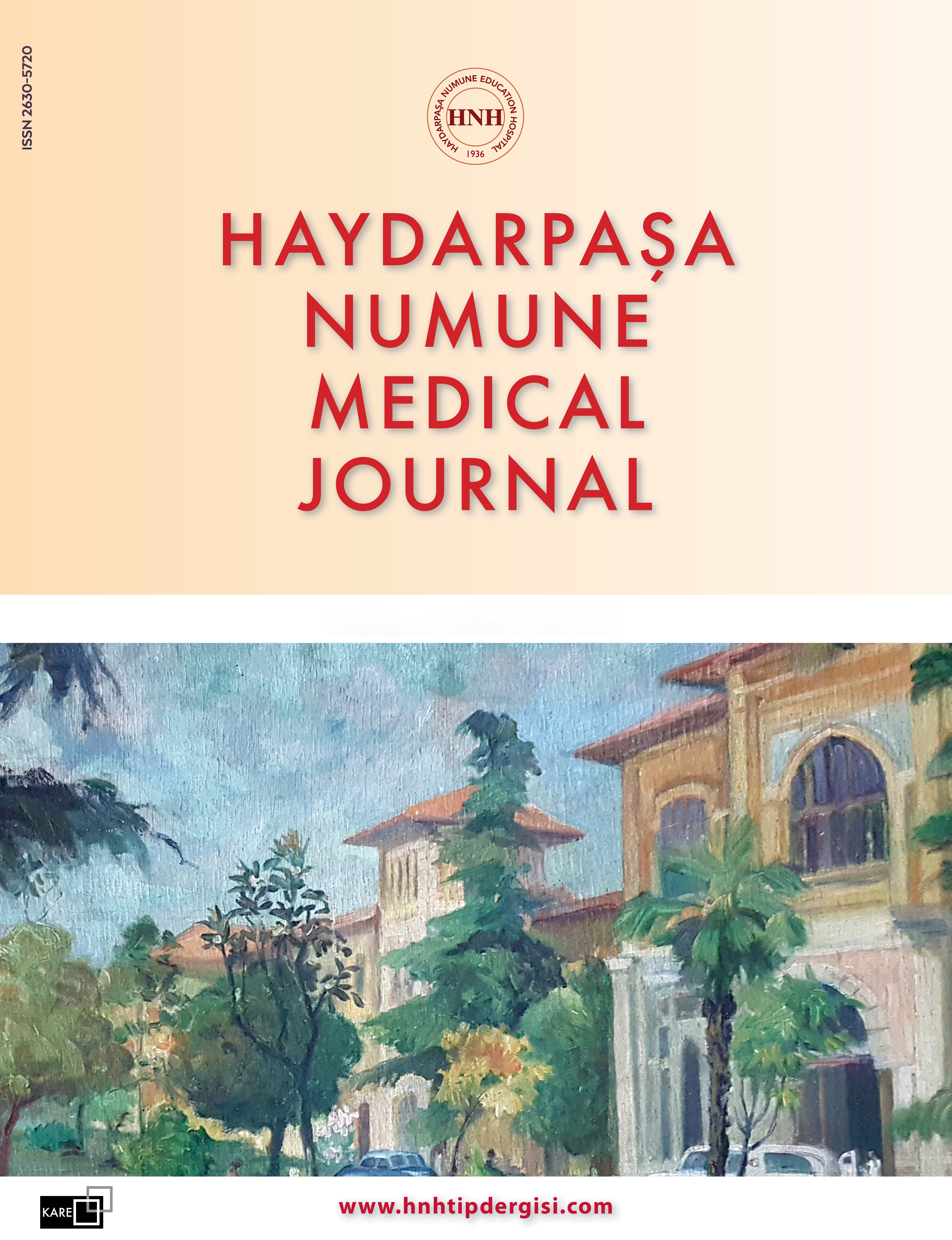Volume: 57 Issue: 1 - 2017
| RESEARCH ARTICLE | |
| 1. | Risk Factors and Treatment Modalities in Ectopic Pregnancy Cases Alim G. Kuşgöz, Nurettin Aka, A. Deniz E. Coşkun, Gültekin Köse, E. Can Tüfekçi Pages 1 - 5 INTRODUCTION: To analyse the ectopic pregnancy cases retrospectively considering their initial complaits, risc factors and treatment methods. METHODS: The data of 59 patients who were seen at the Haydarpaşa Numune Education and Research Hospital Obstetrics and Gynecology Clinic were analysed retrospectively. All cases were analysed considering their etiological risc factors and complaints. The patients that received surgical or medical treatment were compared in terms of their ultrasonographic findings, labaratory results and treatment success. RESULTS: The mean age of the patients was 32±6.0. The initial complaints of the patients were vaginal bleeding (32.2%), pelvic pain (28.8%), vaginal bleeding and pelvic pain(27,1%), delayed menstruation only (5,1%), and admittance to emergency room with hypovolemic shock findings (5.1%). 40,7 % of the cases had non-specific histories, 13.6 % had pelvic inflammatory disease,1.7% had prior tubal surgery, 1.9% had history of ectopic pregnancy,15.3% had intra uterine device (IUD), 1.7% had levanorgestrel IUD, 1.7% had uterine anomaly, 13.6% had prior cesarean section. 54.3% were treated with Methotrexate, 3.4% were followed without treatment, 40.7% had surgical treatment. Among patients treated with Methotrexate 6 patients required a second dose, and two patients required surgery. Methotrexate was effective for 93.7% of those given the treatment.. DISCUSSION AND CONCLUSION: History of pelvic inflammatory disease and IUD use were commonly encountered risk factors in our study group. Among the treatment modalities, Methotraxate was a quite effective method for conservative treatment of selected cases. |
| 2. | Cerebral Palsy: Sociodemographic and Clinical Features Kürşat Bora Çarman, Çoşkun Yarar, Arzu Ekici, Sibel Laçiner Gürlevik, Sevgi Yimencioğlu, Ozan Koçak, Burca Ayvacı, İlhan Işık, Didem Arslantaş, Ayten Yakup Pages 6 - 10 INTRODUCTION: Cerebral palsy (CP) is one of the important diseases in child neurology practice. The aim of this retrospective study was to evaluate the demographic and clinical proper-ties of patients. METHODS: One hundred and thirty-four patients who came to the control visit were taken into study. The mean age of patients was 6.73 ± 3.45 and 38.1% of cases were girl. The 15.7 % of patients were premature. The CP type was spastic in 123 patients and eighteen of them were unilateral. The gross motor activity scale was level 5 in most of patients. RESULTS: The frequencies of epilepsy and mental retardation were 54.5% and 32.8% respectively. DISCUSSION AND CONCLUSION: In conclusion, the determination of demographic and clinical features of CP is important for the development of multidisciplinary treatment modalities. |
| 3. | Retrospective Evaluation Of Patients With Kawasaki Syndrome Nurdan Erol, Yusuf İzzet Ayhan, Hilal İmamoğlu Pages 11 - 15 INTRODUCTION: Kawasaki syndrome; is childhood vasculitis with unknown etiology affecting small medium sized vessels, mostly small children under 5 years.The Syndrome affects coronary arteries up to 25 % of untreated cases, andI t is increasingly well known. In this study; We aimed to investigate Kawasaki Syndrome cases who followup at the pediatric cardiology clinics. METHODS: The datas of findings Kawasaki Syndrome and cases with this syndrome obtained from their files at the our pediatric cardiology policlinic. RESULTS: In this study There were 45 (65%) male and 24 (35%) female totally 69 patients. The age of disease of patients was 40; 4 months ± 2.3 (2-144ay) at mean. The number of cases have all the symptoms of Kawasaki diagnostic criteria in 25 (36%). The number of cases have all the symptoms of Kawasaki diagnostic criteria used in 25 (36%), respectively. The only criterion was fever that in all cases. 30 ( 46 %) patients had echocardiographic findings during illness. 22 (30%) of these had coronary involvement. There were left coronary artery involvement in 7 cases, coronary artery in 4 cases, in both coronary artery involvement in 11 cases.The coronary artery involvement had improvement in 7(10%) patients at the follow-up.The IVIG treatment was given before 10 days in 45(%69) of cases. Laboratory findings of the cases were discussed also. DISCUSSION AND CONCLUSION: The lack of definitive diagnostic laboratory findings for diagnosis, being incomplete cases and causing delay in diagnosis and having involvement coronary artery increases the importance of this disease. |
| 4. | Forensic Anthropological Evaluation of II. Area Skeletes in İstanbul Küçükçekmece Ömer Turan, Hasan Demirel, Aksel Özdemir Pages 16 - 21 INTRODUCTION: The aim of this research was to identify and determine the cause of death for the archeo- logical excavations, grave openings and the anthrolpologic results of the human remains found in the districts of Avcılar and Kucukcekmece situated in the Kucukcekmece basin in İstanbul province. METHODS: Of the excavated 15 different skeletons, we analysed that five of them belonged to adult male, four were adult female, four were children and two of them were fetus skeletons. We were able to carry out 93% of the height measurements of the 15 skeletons and 100% of their age range. RESULTS: The categoric data of the reseach were analysed using chi-square test, non parametric data with Mann-Whitney U test and the data is given as mean and standard deviation. DISCUSSION AND CONCLUSION: The determinations of the exact location of the graves before excavation, the burial of all the skeletons in single grave, the ability to measure the grave sizes, the opening of the graves under the supervition of experts, the measurements being done at the grave site and the insitu observation of the skeleton positions contributed much to the determination of the exact number of bodies,the high accuracy rate of height and age determination. |
| 5. | Evaluation Of The Agreement Between Histopathology Results Of Transnrectal Biopsy, And Radical ProstatecTomy Specimens Using Parameters Effecting Gleasın Scores Özgür Haki Yüksel, Aytaç Şahi&775;n, Ahmet Ürkmez, Ayhan Veri&775;t Pages 22 - 27 INTRODUCTION: We know that Gleason score is the most important parameter in the decision-making process for the construction of a treatment plan for prostate cancer. The objectiv e of our study is to review the parameters effecting Gleason score. METHODS: A total of 114 male patients who had undergone radical retropubic prostatectomy (RRP) in the Urology Clinics of Fatih Sultan Mehmet Training and Research Hospital between the years 2008, and 2016 with the diagnosis of prostate cancer based on the histopathology results of transrectal ultrasound-guided (TRUS) fine-needle transrectal biopsy specimens were included in the study. Age, pre-biopsy prostate specific antigen (PSA) levels, body mass indices (BMIs), and prostate volumes of the patients measured with the help of TRUS, histopathology results of prostate biopsy, and RRP specimens were retrospectively analyzed. For the evaluation of mutual agreement kappa coefficient was used. RESULTS: In all cases, a moderate level (38.3 %) of agreement was seen between biopsy, and surgical specimens (kappa coefficient of agreement: 0.383; p: 0.001; p<0.01). Overall, in 66.7 % (76/114) of the cases the results were in agreement. When PSA, prostate volume, age, and BMI were evaluated separately, this rate of agreement changed between 60, and 70 %, in parallel with these results. DISCUSSION AND CONCLUSION: In the literature, sample number of studies on the agreement between these parameters with agreement rates varying within a wide spectrum. In our study we also obtained results consistent with those cited in the literature. Although when parameters effective on Gleason score were evaluated separately similar rates of agreement have been observed, we think that new parameters, which can be included in univariate analyses, and nomograms will be identified in the near future. |
| 6. | Predictive Value Of Glasgow Prognostic Score On Transrectal Prostate Biopsy Results Özgür Haki Yüksel, Çağlar Yıldırım, Ahmet Ürkmez, Serkan Akan, Aytaç Şahi&775;n Pages 28 - 34 INTRODUCTION: We aimed to determine predictive value of an inflammation-based, minimally invasive prognostic marker of Glasgow prognostic score (GPS) in the diagnosis of prostate cancer (PCa) before performing prostate needle biopsy so as to decrease possible complications of prostate needle biopsy and increase its prostate cancer-specificity. METHODS: Among a total of 160 patients whose prostate specific antigen (PSA) levels were between 4-10 mg/dl without any suspicion of malignancy on digital rectal examination (DRE) who also underwent prostate needle biopsy. 30 patients whose histopathology results were reported as prostatic adenocarcinoma and 30 randomly selected patients with histologically evidenced chronic prostatitis were included in the study. Before the procedure, serum PSA, C-reactive protein (CRP) and albumin levels, prostate volume, international pros- tate symptom score (IPSS) and presence of other comorbidities were reported. RESULTS: Sixty patients aged 56-75 years (mean: 66.05±5.48 years) were included in the study. Mean ages of the cases, serum PSA and CRP levels were not statistically significantly different between groups (p>0.05). Mean albumin level of the chronic prostatitis (CP) group was statistically sig- nificantly higher relative to the PCa group (p: 0.005; p<0.01). In addition, mean GPS was statistically significantly lower in the CP group (p: 0.008; p<0.01). DISCUSSION AND CONCLUSION: In this pilot study, we have seen that while deciding to perform prostate needle biopsy in patients with total PSA levels between 4-10 mg/dl without any evidence of suspect malignancy on DRE, higher GPSs may predict diagnosis of prostate cancer. In consideration of the results of this study, diagnostic use of this validated prognostic parameter may pave the way for the conduction of further relevant studies. |
| 7. | Investigation Of The Role Of Inflammatory Cytokins In Patients With Angina Pectoris Tolga Yakar, Refik Demirtunç Pages 35 - 41 INTRODUCTION: The role of acut inflammatoryu reaction in unstable angina pectoris was investigated in this study. METHODS: A total of 72 patients including 23 women and 49 men patients have been included in the study. The patients were divided into two groups, as patients with stable angina pectoris (n=29) and patients with unstable angı- na pectoris (n=43). High-sensitivity C-reactive protein (hs-CRP), fibrinogen and interleukin-6 (IL-6) levels were investigated and compared between two groups. RESULTS: The mean age of patients was 57.3±8.1. Mean body mass index was 27.5±3.1. hs-CRP, Fibrinogen, and IL-6 levels of patients with unstable-angina pectoris (16.68±10.8 mg/dL, 451.2±119.8 mg/dl, 21.2±13.3 pg/mL, respectively) were significantly (p<0.05) higher than patients with stable angina pectoris (6.61±4.4 mg/dL, 383.7±109.6 mg/dl, 7.5±2.8 pg/mL). There were significant correlations between fibrinogen and hs-CRP (r=), between fibrinogen-IL-6 (r=) and between IL-6 ve hs-C- RP arasında (r=) (p<0.05 for all). DISCUSSION AND CONCLUSION: In this study, significant findings that show the role of inflammation in unstable angina pectoris were found. |
| 8. | Urinary Excreations of Calcium, Magnesium, Phospahate, Uric Acid in 2-16 Years Old Healthy Turkish Children Behçet Şimşek, İsmail İşlek Pages 42 - 47 INTRODUCTION: Previous studies indicate that nor- mal values for urinary excretions of the consti- tuents that are responsible in the pathogenesis of diseases like urinary stone disease,hematu- ria, reccurent urinary tract infection may vary according to age, sex, diet traditions in different regions. Reference values of the related cons- tituents were not available for Turkish children. METHODS: The aim of this study was, for the first time in Turkey, to determine the standart reference values for excretions of calcıum, magnesium, phosphate, uric acid and creatinine in the first morning and 24-h urine samples in 2-16 years old healthy children in Samsun region. RESULTS: A total of 203 children (88 girls, 115 boys), aged 2-16 years partici- pated in the study. The relationships between the dietary intake and the urinary excretion of the minerals in the first morning and 24-h urine samples were investigated.The 50p and 95p values for urinary excretions of calcium were 2.6 and 6.73 mg/ kg/day; for magnesium 1.16 and 2.43 mg/kg/ day, for uric acid 10.21 and 19.71 mg/kg/day, for phospate 19.21 and 37.11 mg/kg/day,for creatinine 20.61 and 29.58 mg/kg/day respe- ctively. Asemptomatic hypercalciuria and hy- peruricosuria were diagnosed in 3.4% and 4.4 %of children who were enrolled in the study respectively. DISCUSSION AND CONCLUSION: There was no significant correla- tion between the dietary intake and the urinary excretions of the constituents. There was also no significant correlation between the urinary excretions of the constituents in the first mor- ning and 24-h urine samples, therefore we su- ggest that the first morning urine samples can not replace the 24-h urine sample measure- ments. |
| CASE REPORT | |
| 9. | A Rare Etiology in A Patient Admitted For Abdominal Pain Syndrome Isolated Idiopathic Hypercalciuria Adem Yaşar, Belma Yaşar, Muhittin Atar Pages 48 - 49 Idiopathic hypercalciuria is a disease characterized by normal serum calcium levels and high levels of calcium excreted in urine, that is overlooked in most patients due to being asymptomatic but which recurs in its later stages and leads to urinary system pathologies. We presented it because it is a disease that should be kept in mind in the case of children with recurrent abdominal pain. |
| 10. | Necrotizing fasciitis of the abdominal wall due to pseudomonas aeruginosa enfection successfully treated by negative pressure wound therapy Emre Günay, Hacı Hasan Abuoğlu, Hacı Mehmet Odabaşı, Erkan Özkan, M. A. Tolga Müftüoğlu Pages 50 - 55 Necrotizing fasciitis is the infection of subcutaneous tissue and fascia. Its a rapidly progressive disease that can result with wide-open wound caused by microorganisms known as flesh-eating bacteria. The most common causes are group A beta-hemolytic streptococcus. Emergency surgical debridement combined with early diagnosis is the main treatment modality in the management of rapidly progressive disease. But often a large open wound remains after surgical debridement for infection management and secondary surgical procedures such as skin grafts, local flaps or free flaps would be needed to close the wound. The delay in closing the open wound may result in delayed infection, deterioration of the patients general condition and generalized sepsis. Prolonged recovery is expected due to the dirty and unstable wound bed after skin grafting. Negative pressure wound therapy (NPWT) is getting used to control chronic wounds due to the effect of reducing the wound edema and increasing the tissue perfusion. We ai- med to present an abdominal wall necrotizing fasciitis case (a 60 year -old immobile, schizophrenic woman) which has been tre- ated in few weeks by 3 steps [1-antibiotics and surgical debridement, 2- negative pressure wound therapy, 3-Late surgical reconstruction (skin graft)]. |
| 11. | A patient with cyst hydatid operated laparoscopically due to intraabdominal rupture after trauma: A case report Nuriye Esen Bulut, Mehmet Mahir Fersahoğlu, Fatih Kılıç, Bülent Kaya Pages 56 - 59 Cyst hydatid is the frequent morbidity in our country. Echinococus commonly localized in liver and lung and it causes chronical infection. In last years laparascopic operations are gained popularity in surgical practice.Intraabdominal rupture after trauma is a rare but serious event. In this case report a patient with cyst hydatid, intraabdominl rupture after trauma and treated with laparoscopic surgery was reported. |
| 12. | A premature infant who is 30 weeks gestational age with Ring Chromosome 13 and Ambiguous Genitalia: A case report Selçuk Gürel Pages 60 - 62 Ring chromosome 13 syndrome is a disease where some developmental and morphological changing have been seen, because of a group of missing geneononlyone of the 13 chrosome pair at short arm, small and long arms have fused together to form a ring. Although this syndrome were showe dupclinically in 1968, the first describing of it has been defined after analysis of genetic. Development delay, feding difficulties, unusual bone structure most commonly footanomaly, highpalate, anus anomalies, small lowjaw, kidney anomalies, heart defects, abnormal brain structure and abnormal eye structure accompany this disease. Ourfact is a firstbaby of a mother at theage of 28 and a father 30 who do not haveanyline of descent. When the baby was born at just 30 weeks by C/S,(sezeryan) along side being prematüre + RDS it had also imperforate anus, ambigus genitalia, cardiac and cerebral anomalies which were determined at prenatal period. During the first monitoring, it was thought that there was chromosome 13 syndrome. The purpose of this essay is to reconsider this disease in thelight of literature with our fact will be presented. |
















